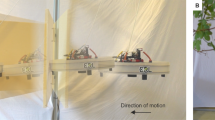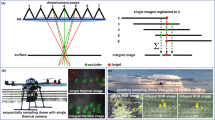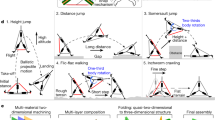Abstract
Classical models of aerial swarms often describe global coordinated motion as the combination of local interactions that happen at the individual level. Mathematically, these interactions are represented with potential fields. Despite their explanatory success, these models fail to guarantee rapid and safe collective motion when applied to aerial robotic swarms flying in cluttered environments of the real world, such as forests and urban areas. Moreover, these models necessitate a tight coupling with the deployment scenarios to induce consistent swarm behaviours. Here, we propose a predictive model that incorporates the local principles of potential field models in an objective function and optimizes those principles under the knowledge of the agents’ dynamics and environment. We show that our approach improves the speed, order and safety of the swarm, it is independent of the environment layout and is scalable in the swarm speed and inter-agent distance. Our model is validated with a swarm of five quadrotors that can successfully navigate in a real-world indoor environment populated with obstacles.
This is a preview of subscription content, access via your institution
Access options
Access Nature and 54 other Nature Portfolio journals
Get Nature+, our best-value online-access subscription
$29.99 / 30 days
cancel any time
Subscribe to this journal
Receive 12 digital issues and online access to articles
$119.00 per year
only $9.92 per issue
Buy this article
- Purchase on Springer Link
- Instant access to full article PDF
Prices may be subject to local taxes which are calculated during checkout





Similar content being viewed by others
Data availability
Complementary data for reproducing the experiments are available in the Supplementary Information. Simulation and hardware experimental data that support the findings of this study can be downloaded from ref. 54.
Code availability
The code that supports the findings of this study can be downloaded from ref. 55.
References
Couzin, I. D., Krause, J., Franks, N. R. & Levin, S. A. Effective leadership and decision-making in animal groups on the move. Nature 433, 513–516 (2005).
Hildenbrandt, H., Carere, C. & Hemelrijk, C. K. Self-organized aerial displays of thousands of starlings: a model. Behav. Ecol. 21, 1349–1359 (2010).
Young, G. F., Scardovi, L., Cavagna, A., Giardina, I. & Leonard, N. E. Starling flock networks manage uncertainty in consensus at low cost. PLoS Comput. Biol. 9, e1002894 (2013).
Dell’Ariccia, G., Dell’Omo, G., Wolfer, D. P. & Lipp, H.-P. Flock flying improves pigeons’ homing: GPS track analysis of individual flyers versus small groups. Anim. Behav. 76, 1165–1172 (2008).
Nagy, M., Ákos, Z., Biro, D. & Vicsek, T. Hierarchical group dynamics in pigeon flocks. Nature 464, 890–893 (2010).
Yomosa, M., Mizuguchi, T., Vásárhelyi, G. & Nagy, M. Coordinated behaviour in pigeon flocks. PLoS ONE 10, e0140558 (2015).
Ballerini, M. et al. Interaction ruling animal collective behavior depends on topological rather than metric distance: evidence from a field study. Proc. Natl. Acad. Sci. USA 105, 1232–1237 (2008).
Floreano, D. & Wood, R. J. Science, technology and the future of small autonomous drones. Nature 521, 460–466 (2015).
Stirling, T., Roberts, J., Zufferey, J.-C. & Floreano, D. Indoor navigation with a swarm of flying robots. In Proc. IEEE International Conference on Robotics and Automation (ICRA) 4641–4647 (IEEE, 2012).
McGuire, K. N., Wagter, C. D., Tuyls, K., Kappen, H. J. & de Croon, G. C. H. E. Minimal navigation solution for a swarm of tiny flying robots to explore an unknown environment. Sci. Robot. 4, eaaw9710 (2019).
Erman, A. T., van Hoesel, L., Havinga, P. & Wu, J. Enabling mobility in heterogeneous wireless sensor networks cooperating with UAVs for mission-critical management. IEEE Wirel. Commun. 15, 38–46 (2008).
Tagliabue, A., Kamel, M., Siegwart, R. & Nieto, J. Robust collaborative object transportation using multiple MAVs. Int. J. Robot. Res. 38, 1020–1044 (2019).
Augugliaro, F. et al. The flight assembled architecture installation: cooperative construction with flying machines. IEEE Control Syst. Mag. 34, 46–64 (2014).
Intel drone light show: Intel’s 50th anniversary (Intel, 21 November 2019); https://www.intel.com/content/www/us/en/technology-innovation/videos/drone-light-show-50th-anniversary-video.html
EHang Egret’s 1,374 drones dancing over the City Wall of Xian, achieving a Guinness World Records title (EHang, 2 May 2018); https://www.ehang.com/news/365.html
The Globe and Mail: mini-drone use on the rise to light up big concerts like Celine Dion and Drake (Verity, 6 December 2019); https://veritystudios.com/news/globe-and-mail-celine
Chen, D., Liu, X., Xu, B. & Zhang, H.-T. Intermittence and connectivity of interactions in pigeon flock flights. Sci. Rep. 7, 10452 (2017).
Berdahl, A., Torney, C. J., Ioannou, C. C., Faria, J. J. & Couzin, I. D. Emergent sensing of complex environments by mobile animal groups. Science 339, 574–576 (2013).
Couzin, I. D. Synchronization: the key to effective communication in animal collectives. Trends Cogn. Sci. 22, 844–846 (2018).
Reynolds, C. W. Flocks, herds and schools: a distributed behavioral model. Comput. Graph. 21, 25–43 (1987).
Hauert, S. et al. Reynolds flocking in reality with fixed-wing robots: communication range versus maximum turning rate. In Proc. IEEE/RSJ International Conference on Intelligent Robots and Systems (IROS) 5015–5020 (IEEE, 2011).
Schilling, F., Lecoeur, J., Schiano, F. & Floreano, D. Learning vision-based flight in drone swarms by imitation. IEEE Robot. Autom. Lett. 4, 4523–4530 (2019).
Olfati-Saber, R. Flocking for multi-agent dynamic systems: algorithms and theory. IEEE Trans. Autom. Control 51, 401–420 (2006).
Vásárhelyi, G. et al. Optimized flocking of autonomous drones in confined environments. Sci. Robot. 3, eaat3536 (2018).
Vasarhelyi, G. et al. Outdoor flocking and formation flight with autonomous aerial robots. In Proc. IEEE/RSJ International Conference on Intelligent Robots and Systems (IROS) 3866–3873 (IEEE, 2014).
Koren, Y. & Borenstein, J. Potential field methods and their inherent limitations for mobile robot navigation. In Proc. IEEE International Conference on Robotics and Automation (ICRA) 1398–1404 (IEEE, 1991).
Soria, E., Floreano, D. & Schiano, F. The influence of limited visual sensing on the Reynolds flocking algorithm. In Proc. Third IEEE International Conference on Robotic Computing (IRC) 138–145 (IEEE, 2019).
Borrelli, F., Bemporad, A. & Morari, M. Predictive Control for Linear and Hybrid Systems 1st edn (Cambridge Univ. Press, 2017).
Grune, L. & Pannek, J. Nonlinear Model Predictive Control. Theory and Algorithms (Springer, 2011).
Baca, T., Hert, D., Loianno, G., Saska, M. & Kumar, V. Model predictive trajectory tracking and collision avoidance for reliable outdoor deployment of unmanned aerial vehicles. In Proc. IEEE/RSJ International Conference on Intelligent Robots and Systems (IROS) 6753–6760 (IEEE, 2018).
Falanga, D., Foehn, P., Lu, P. & Scaramuzza, D. PAMPC: Perception-Aware Model Predictive Control for quadrotors. In Proc. IEEE/RSJ International Conference on Intelligent Robots and Systems (IROS) 1–8 (IEEE, 2018).
Luis, C. E., Vukosavljev, M. & Schoellig, A. P. Online trajectory generation with distributed model predictive control for multi-robot motion planning. IEEE Robot. Autom. Lett. 5, 604–611 (2020).
Keviczky, T., Borrelli, F., Fregene, K., Godbole, D. & Balas, G. J. Decentralized receding horizon control and coordination of autonomous vehicle formations. IEEE Trans. Control Syst. Technol. 16, 19–33 (2008).
Van Parys, R. Distributed MPC for multi-vehicle systems moving in formation. Robot. Auton. Syst 97, 144–152 (2017).
Eren, U. et al. Model predictive control in aerospace systems: current state and opportunities. J. Guid. Control Dyn. 40, 1541–1566 (2017).
Dunbar, W. B. & Murray, R. M. Distributed receding horizon control for multi-vehicle formation stabilization. Automatica 42, 549–558 (2006).
Raffard, R. L., Tomlin, C. J. & Boyd, S. P. Distributed optimization for cooperative agents: application to formation flight. IEEE Conf. Decision Control 3, 2453–2459 (2004).
Schouwenaars, T., How, J. & Feron, E. Decentralized cooperative trajectory planning of multiple aircraft with hard safety guarantees. In Proc. AIAA Guidance, Navigation and Control Conference (AIAA, 2004); https://doi.org/10.2514/6.2004-5141
Richards, A. & How, J. Implementation of robust decentralized model predictive control. In Proc. AIAA Guidance, Navigation and Control Conference (AIAA, 2005); https://doi.org/10.2514/6.2005-6366
Kuwata, Y. & How, J. P. Robust cooperative decentralized trajectory optimization using receding horizon MILP. In Proc. 2007 American Control Conference 522–527 (IEEE, 2007); https://doi.org/10.1109/ACC.2007.4283003
Erunsal, I. K., Martinoli, A. & Ventura, R. Decentralized nonlinear model predictive control for 3D formation of multirotor micro aerial vehicles with relative sensing and estimation. In Proc. 2019 International Symposium on Multi-Robot and Multi-Agent Systems (MRS) 176–178 (IEEE, 2019).
Zhao, W. & Go, T. H. Quadcopter formation flight control combining MPC and robust feedback linearization. J. Frankl. Inst. 351, 1335–1355 (2014).
Ren, W. & Sorensen, N. Distributed coordination architecture for multi-robot formation control. Robot. Auton. Syst. 56, 324–333 (2008).
Kamel, M., Alonso-Mora, J., Siegwart, R. & Nieto, J. Robust collision avoidance for multiple micro aerial vehicles using nonlinear model predictive control. In Proc. IEEE/RSJ International Conference on Intelligent Robots and Systems (IROS) 236–243 (IEEE, 2017).
Kumar, V. & Michael, N. Opportunities and challenges with autonomous micro aerial vehicles. Int. J. Robot. Res. 31, 1279–1291 (2012).
Petrlík, M. et al. A robust UAV system for operations in a constrained environment. IEEE Robot. Autom. Lett. 5, 2169–2176 (2020).
Sapkota, K. R. et al. Vision-based unmanned aerial vehicle detection and tracking for sense and avoid systems. In Proc. IEEE/RSJ International Conference on Intelligent Robots and Systems (IROS) 1556–1561 (IEEE, 2016).
Hunt, E. R. & Hauert, S. A checklist for safe robot swarms. Nat. Mach. Intell. 2, 420–422 (2020).
Lindqvist, B., Mansouri, S. S., Agha-mohammadi, A. & Nikolakopoulos, G. Nonlinear MPC for collision avoidance and control of UAVs with dynamic obstacles. IEEE Robot. Autom. Lett. 5, 6001–6008 (2020).
Strandburg-Peshkin, A. et al. Visual sensory networks and effective information transfer in animal groups. Curr. Biol. 23, 709–711 (2013).
Chen, Z. & Chu, T. Multi-agent system model with mixed coupling topologies for pattern formation and formation splitting. Math. Comput. Model. Dyn. Syst. 19, 388–400 (2013).
Verschueren, R. et al. Towards a modular software package for embedded optimization. IFAC-PapersOnLine 51, 374–380 (2018).
Frison, G., Kufoalor, D. K. M., Imsland, L. & Jørgensen, J. B. Efficient implementation of solvers for linear model predictive control on embedded devices. In Proc. IEEE Conference on Control Applications (CCA) 1954–1959 (IEEE, 2014).
Soria, E., Schiano, F. & Floreano, D. Predictive control of aerial swarms in cluttered environments [dataset]. Zenodo https://doi.org/10.5281/zenodo.4379168 (2020).
Soria, E., Schiano, F. & Floreano, D. Predictive control of aerial swarms in cluttered environments [code repository]. Zenodo https://doi.org/10.5281/zenodo.4379503 (2020).
Acknowledgements
We thank A. De Bortoli, M. Pfister and F. Schilling for helpful discussions. This work was supported by the Swiss National Science Foundation under grant no. 200020_188457. This work was also partially funded by the European Union’s Horizon 2020 research and innovation programme under grant agreement ID 871479 AERIAL-CORE.
Author information
Authors and Affiliations
Contributions
All authors contributed to the conception of the project and were involved in the analysis of the results. E.S. designed, implemented and performed software and hardware experiments of the NMPC algorithm for the navigation of drone swarms in cluttered environments. All authors contributed to the writing of the manuscript.
Corresponding authors
Ethics declarations
Competing interests
The authors declare no competing interests.
Additional information
Peer review information Nature Machine Intelligence thanks George Nikolakopoulos, Shan Luo and the other, anonymous, reviewer(s) for their contribution to the peer review of this work.
Publisher’s note Springer Nature remains neutral with regard to jurisdictional claims in published maps and institutional affiliations.
Supplementary information
Supplementary Video 1
Simulation experiments.
Supplementary Video 2
Hardware experiments.
Rights and permissions
About this article
Cite this article
Soria, E., Schiano, F. & Floreano, D. Predictive control of aerial swarms in cluttered environments. Nat Mach Intell 3, 545–554 (2021). https://doi.org/10.1038/s42256-021-00341-y
Received:
Accepted:
Published:
Issue Date:
DOI: https://doi.org/10.1038/s42256-021-00341-y
This article is cited by
-
Autonomous 3D positional control of a magnetic microrobot using reinforcement learning
Nature Machine Intelligence (2024)
-
Predictive search model of flocking for quadcopter swarm in the presence of static and dynamic obstacles
Swarm Intelligence (2024)
-
Aerodynamic effect for collision-free reactive navigation of a small quadcopter
npj Robotics (2023)
-
Diverse behaviors in non-uniform chiral and non-chiral swarmalators
Nature Communications (2023)
-
Obstacle avoidance for a robotic navigation aid using Fuzzy Logic Controller-Optimal Reciprocal Collision Avoidance (FLC-ORCA)
Neural Computing and Applications (2023)



